How do you best look after your pond in winter?
14 min read
How to look after your pond in winter, the big Do’s and Don’ts!
🐟 Pond Winter Care Guide
A Pragmatic Aquarist’s Handbook with real-world applications for looking after your pond in winter
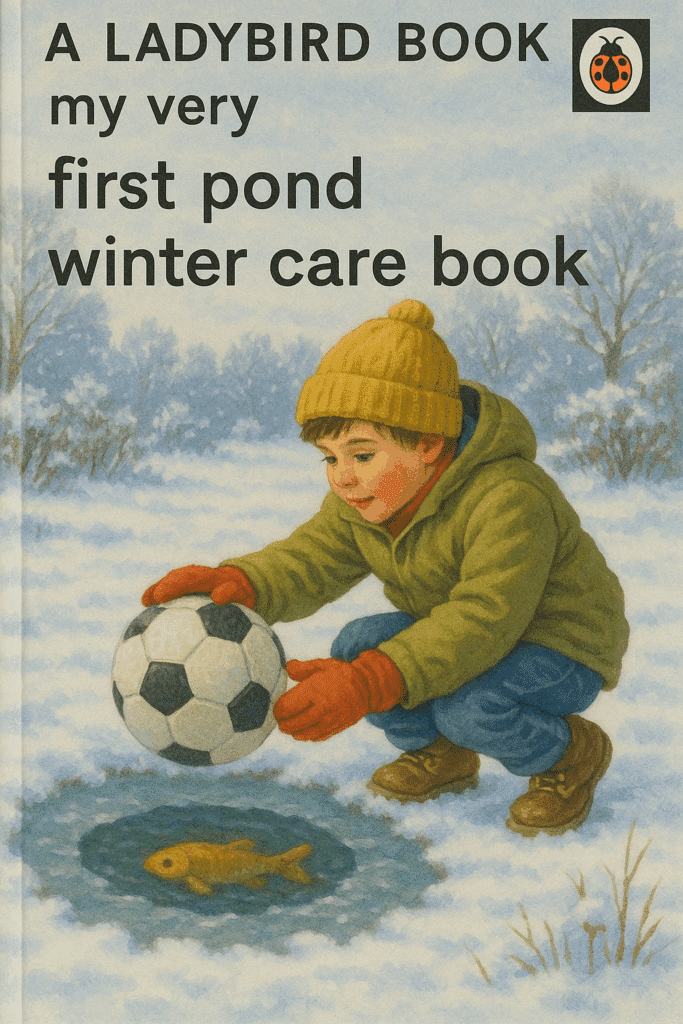
⭐ Foreword: From The Pragmatic Aquarist
Welcome to this winter pond care guide — written not by a biologist in a lab coat, nor a mystical koi whisperer, but by someone who has spent decades helping real people avoid real problems in real ponds. Someone who has thawed frozen pipes, replaced fractured quartz sleeves, diagnosed mysterious winter fish deaths, and comforted more distraught pond-keepers than I can count.
If you’re anything like me, you’ve probably learned much of your fishkeeping wisdom through trial, error, and the occasional “that seemed like a good idea at the time…” moment. That’s the heart of what I call The Pragmatic Aquarist approach: yes, there are a few hard rules — but beyond those, fishkeeping must fit around your life, not take it over.
I can only offer best practices, not commandments.
And yes, you might have a routine that has worked “perfectly fine for years”…
until the day the perfect storm arrives — the one winter where all the little things you have or haven’t been doing suddenly pile up and put you in a spot of aquatic bother.
Even small tweaks — one percent improvements — in the right direction can make a massive difference when winter hits hard.
To paint the picture of the Pragmatic Aquarist mindset, I read a comment recently on Facebook where someone innocently asked for a bit of advice. Immediately — the voice of god descended:
“A KOI POND SHOULD BE 8 FEET DEEP AND HAVE AT LEAST TWO BOTTOM DRAINS.”
Alright then, Mr Koi-God. Yes, in an ideal world, perhaps.
(Although let’s be honest — an 18” koi looks more like 12” when you’re peering down into an 8ft abyss.)
But not everyone can build a pond like that — myself included.
This guide is not about perfection.
It’s about practicality, picking your battles, and helping your pond survive and thrive through winter — realistically, affordably, and without guilt.
Now, let’s begin with the most common mistakes people make every single winter — myself and my family included.
❄️ Part 1 — The Most Common Winter Pond Mistakes
Winter is when ponds are at their most vulnerable.
Cold water, reduced fish metabolism, slower bacteria activity, increased rainfall, and increased debris all combine to create the perfect conditions for trouble… unless you know what to look out for. But it’s also when we spend the least time around our ponds. So how do you best look after your pond in winter? The damage done in winter is not always immediately apparent. Fish and the pond ecosystem as a whole can be weakened, and it’s not until spring when things really fall apart…The ripple effect I suppose!
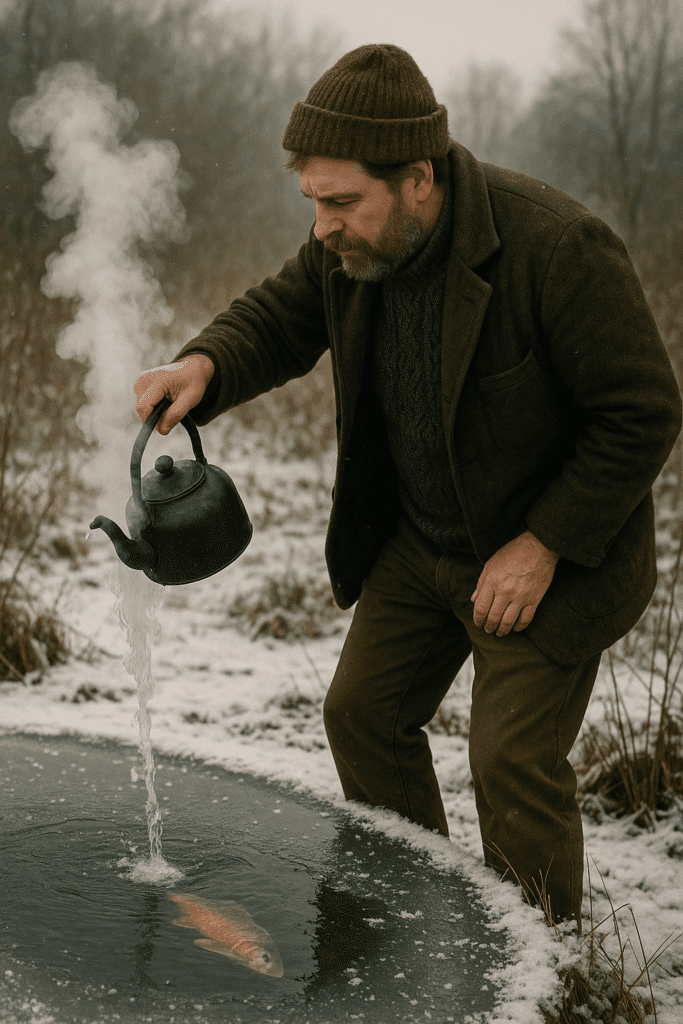
❄️ Mistake 1: The Famous Football on the Pond
In the first home I can remember — I must have been four or five — I recall my dad placing a football on the pond at the bottom of the garden in winter
Yes… John Cook. “The Founder.”
(👼 cue angelic AHHHHHHHHHs)
Dad meant well. Lots of people did (and still do), but that was the late 70’s and now we know better!
The idea was that the ball would stop the pond freezing over completely. You can remove the football to create that ice free space (news flash…most people forgot this part)
A lovely theory… with absolutely zero scientific basis.
A football does not:
- Create warm water
- Prevent freezing
- Maintain gas exchange
But it does roll about looking helpful, like a floating lifeguard on tea break, until the water freezes, then it just becomes part of the problem
We’ll show you what actually works.
❄️ Mistake 2: Turning the Pump Off
Fish slow down in winter, but they don’t stop needing oxygen.
Your pump is the heart of your pond’s ecosystem. It keeps oxygen circulating, waste moving, and beneficial bacteria alive.
Turning it off shuts down:
- Oxygen delivery
- Circulation
- Biological filtration
- Ammonia conversion
- Winter protection
It also means you’ll need to “reboot” the entire filter system in spring — which is when your fish are at their weakest.
We’ll explain what to do instead shortly.
❄️ Mistake 3: Raising the Pump Off the Bottom
At some point, a myth started circulating that ponds should have their pumps “lifted up” in winter.
Let me reassure you:
Your pump does not need protection from cold water — it’s designed for it.
But your fish do need protection from stagnation at the bottom of the pond.
Lifting your pump:
- Reduces circulation where fish are living
- Reduces oxygen delivery
- Allows stale layers to build
- Increases risk of winter/spring deaths
Leave the pump where it belongs — on the bottom, doing its job.
❄️ Mistake 4: Skipping Filter Maintenance (AKA Skipping Leg Day)
Skipping filter maintenance in winter is like skipping:
- leg day,
- cardio day,
- chest day,
- back day,
- and arms day…
for three months.
Yes, fish produce less waste in winter, but nature produces plenty:
- Leaves
- Twigs
- Mud
- Algae die-off
- Dust
- Storm debris
- Sludge build up (algae, blanket weed & duck weed food to you and me)
A pragmatic cleaning rhythm looks like:
- Summer: Weekly
- Spring & Autumn: Fortnightly
- Winter: Monthly
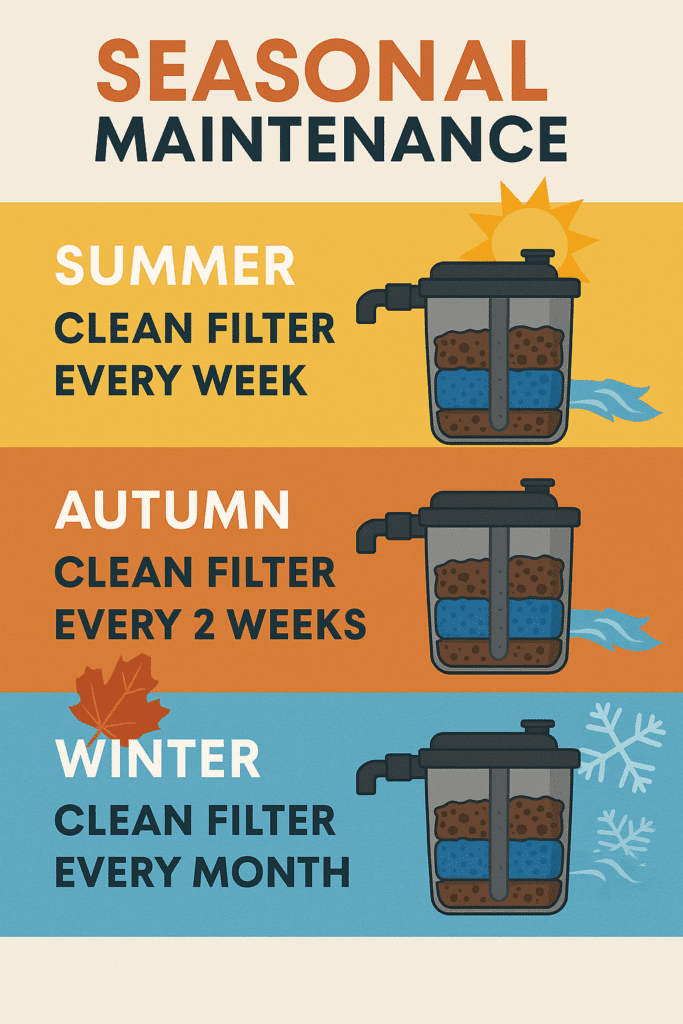
Winter debris is sneaky.
It settles quietly… and then in spring, it unleashes chaos.
Sludge busting products are really helpful, but remember, they are biological, so their actions will be limited when pond water temperatures are at their lowest
Regular filter maintenance:
✔ Prolongues pump life
✔ Prevents clogs
✔ Maintains oxygen levels
✔ Stops toxic anaerobic sludge
✔ Supports beneficial bacteria
✔ Prevents ammonia spikes
❄️ Mistake 5: Ignoring Water Tests — Especially KH
Every spring, I meet people heartbroken because they’ve lost one or several large fish — seemingly without warning.
One by one, the fish roll over and die. Quietly. Mysteriously.
And it’s almost always the same cause:
A winter KH crash → pH crash → ammonia spike → acidosis → fish deaths.
This happens when:
- You live in a soft water area
- Your pond tops up mostly with rainwater
- Leaves accumulate
- KH drops to zero
KH is the buffer that stops your water turning acidic.
Without KH, your pond becomes chemically unstable. The good bacteria can’t function properly, waste builds up & your fish can’t export toxins from their system
We’ll dive deeper into KH as the #1 correct winter procedure.
❄️ Mistake 6: Feeding Fish Normally in Winter
Below 6°C, fish cannot physically digest food.
Anything eaten will:
- Sit in their gut
- Rot internally
- Cause health issues
- Damage water quality
Feeding “as normal” is one of the fastest ways to cause winter harm.

We’ll show you the correct feeding temperatures shortly.
❄️ Mistake 7: Letting Leaves Build Up
Leaves don’t just look messy — they actively make winter harder.
They:
- Lower KH
- Lower pH
- Consume oxygen
- Add extra bio-load
- Decompose into sludge
❄️ Mistake 8: Not feeding at all
Whilst you shouldn’t feed below 6 degrees, there are plenty of foods fish can digest above this temperature, feeding the right food at the right time can give your fish the stamina they need to get through the winter and come out fighting in spring
❄️ Part 2 — Doing Winter the Right Way
Practical, realistic, no-nonsense ways to best look after your pond in winter
Below are the solutions — not perfection, but best practice, from one pond-keeper to another.
✅ 1. Meet CAPTAIN KH — Your Pond’s Unsung Hero
🦸♂️ Protector of pH! Slayer of Sludge! Abolisher of Ammonia!
When the nights grow cold and the filters slow, one unseen hero keeps your pond from turning into a watery wasteland — Captain KH, defender of stability and all things alkaline.

If there’s one thing you take from this guide, make it this: check your KH.
KH (carbonate hardness) is the buffer that prevents your pond from becoming acidic. When KH hits zero, winter becomes deadly.
What causes KH crashes?
- Soft tap water
- Rainwater top-ups
- Leaf litter
- Natural biological processes
- Lack of buffering minerals
- Build up of CO2
- Lack of plant and algae growth, that would normally absorb excess CO2
What happens during a KH crash?
- pH drops (sometimes to 5)
- Filter bacteria stop functioning
- Ammonia spikes
- Fish can’t excrete waste properly (acidosis)
- Fish die quietly over winter and early spring
What to do
- Test KH in autumn, winter, and early spring they are one of the easiest and cheapest tests to do.
- Add KH buffer when needed
- Keep KH consistent year-round
🧠 Richard’s Wisdom:
Unfortunately, we have a tendency to act only once things have gone tips up (yes, I said tips).
We exercise after the doctor tells us to, fix things once they break, and generally wait for the wheels to fall off before putting them back on again.
How about testing KH before the ship hits the pram in spring?
Or buffering your water consistently so KH testing becomes a formality?
Wouldn’t that be amazing! being proactive like that? It would be like inviting your GP round to watch you do a Joe Wicks workout!
There are very few things that are more important for pond winter care than keeping an eye on your KH
📬 Richard’s Take-Home (Literally):
Email me at ri*****@**********************co.uk and I’ll post you a single KH dip test free of charge so you can get a baseline.
(We’re still checking logistics — but this is that important.)
✅ 2. Keep Water Circulating
You should keep your pond pump running all winter.
But are smart tweaks you can make to reduce heat loss while keeping the water moving efficiently.
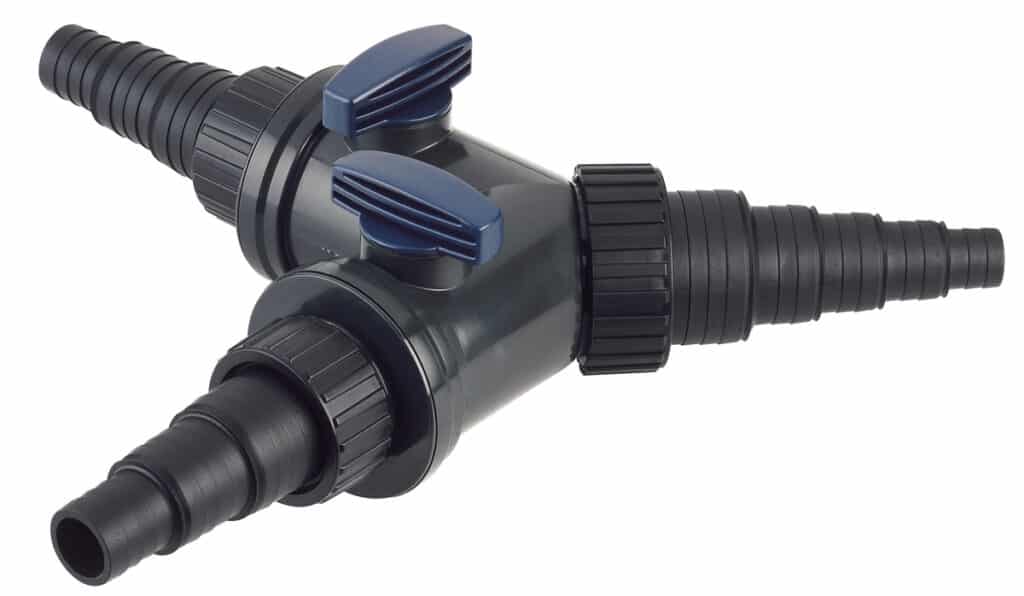
If you have a waterfall, it acts like a reverse radiator in winter — rapidly cooling a thin layer of water as it mixes with cold air.
A simple bypass pipe lets you divert water straight back into the pond during winter and reopen the waterfall in summer. You can easily fit a divertor valve and bypass pipe either during construction. This has the added bonus of allowing you to get the perfect flow of water down your waterfall without putting back pressure on the pump.
Adjust your return flow
Aim for 6 inches below the surface, which:
- Prevents major heat loss
- Improves circulation
- Reduces stress on fish
- Maintains oxygen movement
Some Modern pumps are soooooo much more efficient
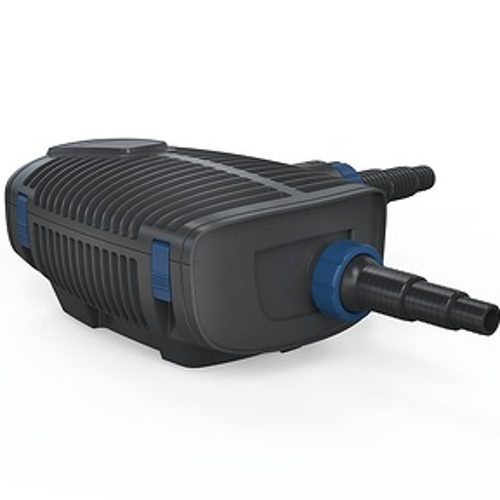
Some modern pumps are sooooooo much more efficient!
Everyone is understandably worried about running cost. Switching to an energy efficient pump that regulates it’s own flow in winter can easily save you £80-£200 a year in running costs
Pro Tip: A pond that circulates properly all year is already halfway to surviving winter effortlessly.
✅ 3. It’s Just a Hole in the Ice, Man — How Difficult Can It Be!
💬 Richard’s Challenge:
Come on, you ingenious wannabe Blue Peter badge owners! If you’ve got a creative way of keeping that blowhole free in the heart of winter, let me know and I’ll happily include it in this guide.
But for now, here are some handy tips…
A frozen pond looks peaceful… but beneath that lid, gases build up and oxygen levels fall.
Your goal is simple:
keep one small area ice-free for gas exchange.
Ways to do it
- Use a small pond heater or floating de-icer
- Float a piece of polystyrene with a hole cut in it (you’ll need to keep an eye on this one)
- Create a gentle surface ripple with your pump return
Whatever you do — don’t smash the ice
It sends shockwaves through the water, stressing fish unnecessarily.
If you need a hole quickly, rest a jug of hot water on the ice and let it melt through naturally.
Pro Tip: You only need a hole about the size of a dinner plate.
It’s not ventilation for a submarine — it’s just a hole in the ice, man.
Some people do add salt to their pond over winter, this does have a number of benefits and would help to reduce the risk of freezing, but please consult one of our team before taking this step
✅ 4. Feeding Through Winter — Less Is More
Feeding fish in winter isn’t about affection — it’s about temperature and timing.
When water drops below 10°C, your fish’s metabolism slows.
Below 6°C, it practically shuts down.
❗ Important:
Fish cannot physically digest food below 6°C.
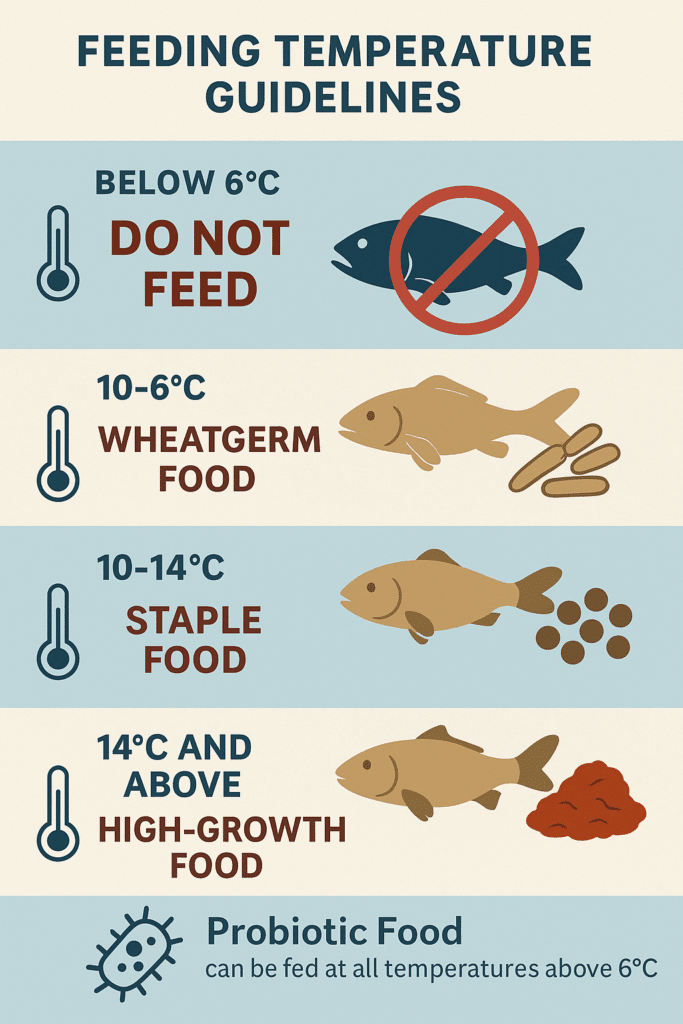
Your winter feeding guide
- Above 10°C → Normal feeding, but smaller portions
- 6–10°C → Switch to wheat germ/probiotic wheat germ. It’s a fatty food that is easier to digest at lower temperatures. Any food that is easier to digest, means the fish has to expend less energy doing so.
- Below 6°C → STOP feeding.
💬 Richard’s Reality Check:
Don’t feel guilty if you skip a feed. Fish don’t run on schedules — and unlike my teenage kids, they won’t starve if they miss a meal.
Pro Tip: Use a cheap pond thermometer. Remove the guess work!
“Feels cold” is not a measurement — even if your toes disagree.

✅ 5. Insulate where you can
Some people think about heating their pond. Ron, one of our Koi experts and Koi show winner, does heat his pond all year round. But, he has taken insulation to the extreme and built a conservatory over his pond! You don’t have to go this far, and I would think long and hard before considering heating your pond, it isn’t necessary and it is most definitely costly.
You can:
- Properly burry or lag your pipes
- Wrap your filter in insulation or even bubble wrap
- Create an insulated cover or frame over the pond.
- If you can’t bypass, then cover your waterfall with a layer of bubble wrap or similar
Richards Wisdom:
You’re not actually aiming to raise your winter temp at all with all of this insulation. What you are trying to do is take away the sharp changes in temperature that can happen, especially in late autumn and early spring. Sunny days: pond warms up, Frosty nights: pond cools down. Fish don’t mind warm water they don’t mind really cold water.
Yo-yoing between warm and cold is what causes the damage and impacts on their immune system. Carp pox ( waxy lumps) is often a sign that temperature variation is having an effect on your fish.
✅ 6. Leaves, Nets & Autumn Prep
Leaves aren’t just a visual annoyance — they actively damage winter water quality.
As they decay, they:
- consume oxygen
- lower KH
- lower pH
- increase sludge
- increase ammonia
- contribute to winter KH crashes
Your options
- Cover net: simple, effective, affordable
- Regular netting/skimming: if your pond is small
- Motorised skimmers: if you have heavy tree coverage. Easy to clean and they’re doing your work for you
- Full pond covers or frames: for vulnerable ponds
Anything that reduces leaf debris will dramatically improve winter survival rates.

❄️ Winter Pond Care: Do’s & Don’ts
✅ Winter Do’s
- Do test KH in autumn, winter and early spring
- Do maintain your filter gently but regularly
- Do keep your pump running all winter
- Do bypass your waterfall if possible
- Do keep a small hole open in the ice
- Do switch to wheat-germ/probiotic food between 6–10°C
- Do stop feeding entirely below 6°C
- Do remove leaves and debris as often as possible
- Do insulate pipework/filters if exposed
- Do use a thermometer — guesswork is not your friend.
❌ Winter Don’ts
- Don’t turn your pump off
- Don’t raise the pump off the bottom
- Don’t smash ice — melt a hole instead
- Don’t feed fish below 6°C, ever
- Don’t let leaves build up into sludge
- Don’t rely on a football to keep a hole open
- Don’t skip filter maintenance
- Don’t assume “it’s always been fine” — winters vary
- Don’t wait until spring to fix winter issues
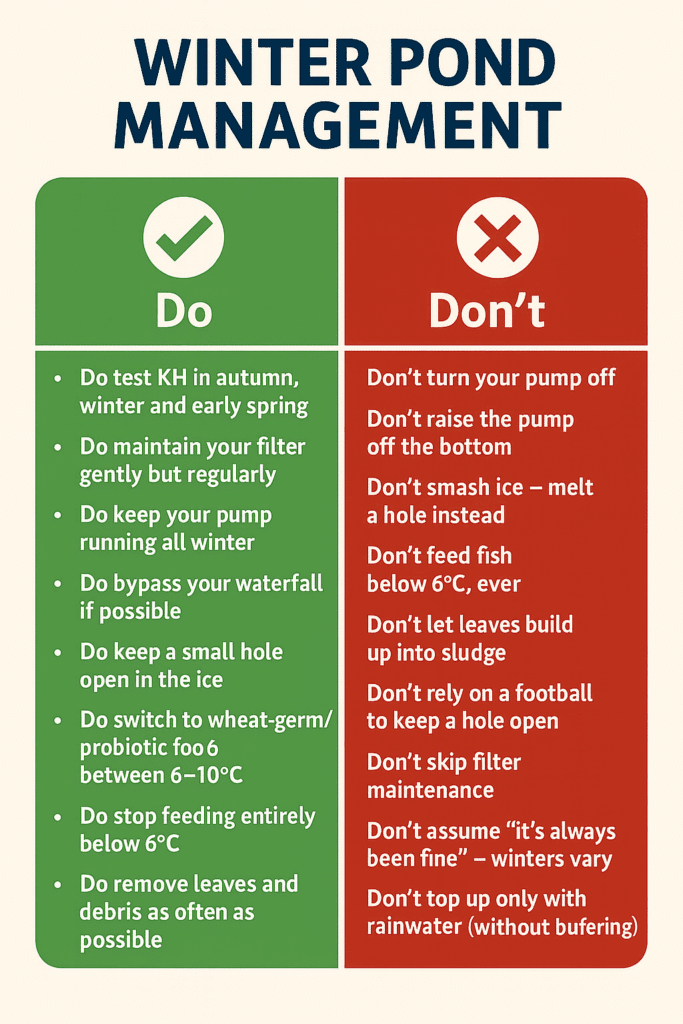
In the end…
This is just a guide, a list of best practices. There are people who do all of these things, there are people who do none of them and haven’t had issues (yet).
I don’t know what the next winter will be like, but I do know, without fail, we will be getting customers in January who have lost fish, which wouldn’t have happened if they had taken at least some of this advice. That doesn’t mean I will dance around saying “ I told you so” I will give them the exact same advice in an effort to stop the same thing happening again the following year.






